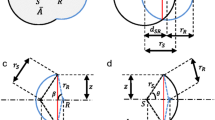Abstract
Node localization in wireless networks is crucial for supporting advanced location-based services and improving the performance of network algorithms such as routing schemes. In this paper, we study the fundamental limits for time delay based location estimation in cooperative relay networks. The theoretical limits are investigated by obtaining Cramer–Rao Lower Bound (CRLB) expressions for the unknown source location under different relaying strategies when the location of the destination is known and unknown. More specifically, the effects of amplify-and-forward and decode-and-forward relaying strategies on the location estimation accuracy are studied. Furthermore, the CRLB expressions are derived for the cases where the location of only source as well as both source and destination nodes are unknown considering the relays as reference nodes. In addition, the effects of the node topology on the location estimation accuracy of the source node are investigated. The results reveal that the relaying strategy at relay nodes, the number of relays, and the node topology can have significant impacts on the location accuracy of the source node. Additionally, knowing the location of the destination node is crucial for achieving accurate source localization in cooperative relay networks.







Similar content being viewed by others
Notes
c is the speed of light.
Collinearity occurs when a relay node is located on the line between S and D nodes.
References
Wang, T., Cano, A., Giannakis, G. B., & Laneman, N. J. (2007). High-performance cooperative demodulation with decode-and-forward relays. IEEE Transactions on Communications, 55(7), 1427–1438.
Laneman, N. J., Tse, D. N. C., & Wornell, G. W. (2004). Cooperative diversity in wireless networks: Efficient protocols and outage behavior. IEEE Transactions on Information Theory, 50(12), 3062–3080.
Cover, T. M., & El Gamal, A. A. (1979). Capacity theorems for the relay channel. IEEE Transaction on Information Theory, 25, 572–584.
Celebi, H., Abdallah, M., Hussain, S. I., Qaraqe, K. A. & Alouini, M. S. (2010). Time of arrival based location estimation for cooperative relay networks. In Proceedings of the IEEE 21st international symposium on personal indoor and mobile radio communications (IEEE PIMRC) (pp. 872–877).
Gezici, S. (2008). A survey on wireless position estimation. Springer Wireless Personal Communications, Special Issue on Towards Global and Seamless Personal Navigation, 44(3), 263–282.
Qi, Y., Kobayashi, H., & Suda, H. (2006). On time-of-arrival positioning in a multipath environment. IEEE Transactions on Vehicular Technology, 55(5), 1516–1527.
Qi, Y., Kobayashi, H., & Suda, H. (2006). Analysis of wireless geolocation in a non-line-of-sight environment. IEEE Transactions on Vehicular Technology, 5(3), 672–681.
Qaraqe, K. A., Hussain, S. I., Celebi, H, Abdallah, M, & Alouini, M. S. (2010). An RSS based location estimation technique for cognitive relay networks. In Proceedings of the 3rd International Workshop on Cognitive Radio and Advanced Spectrum Management (CogART’10).
Brennan, D. G. (2003). Linear diversity combining techniques. Proceedings of the IEEE, 91(2), 331–356.
Turin, G. L. (1960). An introduction to matched filters. IRE Transactions on Information Theory, IT–6(3), 311–329.
Meyr, H., Moeneclaey, M., & Fechtel, S. A. (1998). Digital communication receivers: Synchronization, channel estimation and signal processing. New York: Wiley.
Qi, Y. & Kobayashi, H. (2002). Cramer-Rao lower bound for geolocation in non-line-of-sight environment. In Proceedings of the IEEE International Conference on Acoustics, Speech, and Signal Processing (ICASSP) (pp. 2473–2476).
Choi, Y. (2009). New form of block matrix inversion. In Proceedings of the IEEE/ASME International Conference on Advanced Intelligent, Mechatronics (pp. 1952–1957).
Celebi, H. (2008). Location Awareness in Cognitive Radio Networks. Ph.D. Dissertation, University of South Florida.
Author information
Authors and Affiliations
Corresponding author
Appendix
Appendix
We can represent the log-likelihood function of \(\tau _{i} \varLambda (\tau _{i})\) for the signal at the D node as follows,
where \(\tau _i=\tau _{1i}+\tau _{2i}+\tau _{proc},\quad i=1,2,3,\dots ,M, G=\alpha _ih_{1i}h_{2i}\sqrt{P}\) when the AF relaying strategy is employed and \(G=\sqrt{P}h_{2i}\) when the DF relaying strategy is used. Assume that \(\alpha _i,h_{1i}\) and \(h_{2i}\) are known parameters. Then, the joint log-likelihood function at the D node is given by,
In this case, the unknown parameters at the D node are \(\varvec{\theta }=\left[ \tau _{11},\tau _{12},\dots ,\tau _{1M},\tau _{21},\tau _{22},\dots ,\right. \) \(\left. \tau _{2M} \right] \). In order to calculate the CRLBs for \(\varvec{\theta }\) unknown parameters, the FIM can be obtained as follows,
Using (74), the 2Mx2M FIM matrix is calculated, which is given by,
The elements of \(I_{\varvec{\theta }}\) matrix can be obtained after straightforward manipulations as follows [14],
where \(\gamma _{i}=\frac{G^2}{\sigma ^2_{Ti}}\) and \(\tilde{E}_{i}=\int _0^T \left[ s^{'}(t-\tau _{i})\right] ^2\text {d}t\). We can divide \(I_{\varvec{\theta }}\) matrix into MxM blocks such as,
where
If we apply the block matrix inversion to \(I_{\varvec{\theta }}\) in order to find the CRLBs for \(\varvec{\theta }\) parameters, the first MxM block of \(I^{-1}_{\varvec{\theta }}\) matrix can be obtained as follows,
By using (79), the elements of \(I^{-1}_{\varvec{\theta }}\) get \(\infty \) values. Therefore, the CRLBs for \(\varvec{\theta }\) parameters are \(\infty \), namely, \(\xi ^2_{1i}=\xi ^2_{2i}=\infty ,~i=1,2,3,\dots ,M\).
Rights and permissions
About this article
Cite this article
Celik, G., Celebi, H. Theoretical Limits for Time Delay Based Location Estimation in Cooperative Relay Networks. Wireless Pers Commun 75, 2429–2448 (2014). https://doi.org/10.1007/s11277-013-1475-3
Published:
Issue Date:
DOI: https://doi.org/10.1007/s11277-013-1475-3




